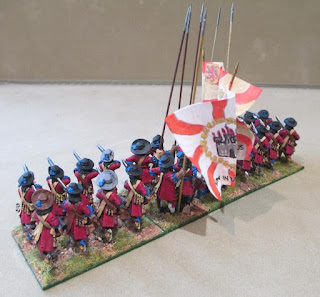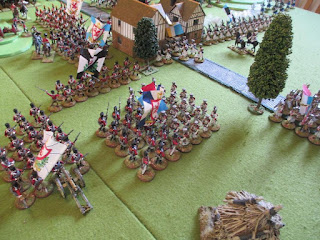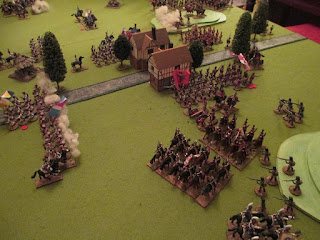And a few other items from the painting table:
Monday 6 December 2021
A few more items from the painting table:
Friday 26 November 2021
As I am sure many of you are aware, I have been running a Napoleonic "imagi-nation" campaign for a while from which I have posted five sets of pictures of the main actions. The inspiration for this campaign came when a copy of C.S. Grant’s “The
Wolfenbüttel War” came into my possession, I read it with interest and
felt inspired to do something similar using my Fescennia “imagi-nation”
Napoleonic figures. I decided that the conflict would be between the
Each map turn represented one
day’s marching, with one square on the map equating to approximately one day’s
march. There was no off-road movement allowed, all units had to move by the
roads and all moved at the same rate, whether cavalry, infantry, artillery or
supply wagons. Couriers moved the equivalent of six days’ marching. A force
which halted for more than one day was allowed to throw up fieldworks if they
wished, but none of the villages had any formal defences, although
Collineville, Nordstadt and Drosselheim were all fortresses. Rivers were only
passable at bridges; however, the Arcadians did have a pontoon train. At the
end of an engagement, the losses were calculated based on a ratio system, so
that some returned to the ranks. In addition, units could be disbanded and
merged into others to keep them up to strength. Victory points were allocated
for certain objectives during a battle – a side could win a tactical victory on
points, but the outcome might be such that they are at a strategic
disadvantage.
To summarise the situation, the
I have put the details of the campaign and its five main scenarios on the link below; feel free to use it as you please, either as a sequence of games, or as "stand alone" actions in their own right. If it is slow to load, give it time!
Monday 22 November 2021
The final action in my Napoleonic "imagi-nation" campaign - the Battle of Teckel-Le-Gtand. The Nemeans, following their so far successful pre-emptive strike into Arcadia - to forestall an invasion by the latter of Nemea - have made a final lunge for Collineville, the regional town. They encountered an Arcadian force moving to block their advance. An encounter battle ensued, with both sides sending in troops off the line of march. Victory went to the Nemeans, but it was a very pyrrhic one, as their losses were twice those of the Arcadians, and the latter won "on points" as a result of the casualties they inflicted, even though they did not secure any of the objectives. The result meant that the Nemeans abandoned their effort to seize Collineville and withdrew to the frontier unmolested. However, the campaign had been a success for them as it had completely disrupted any attempt by the Arcadians to invade Nemea.
The rules are "Old Style", based upon C.Grant's Napoleonic rules, adjusted to fit a 6 feet by 4 feet table and 24 figures infantry units, 12 figure cavalry units and one gun and 4 crew artillery batteries. The figures are mostly metal Hinchliffe 25mm, some metal 25mm Essex, and 28mm Perry and Victrix and plastics, plus a few odds and ends. The Nemeans (Prussian-influenced) are in red or black uniforms, the Arcadians (French-influenced) in white, yellow or light blue. Flags are homemade.
































































































